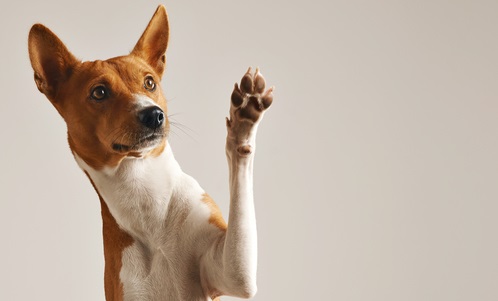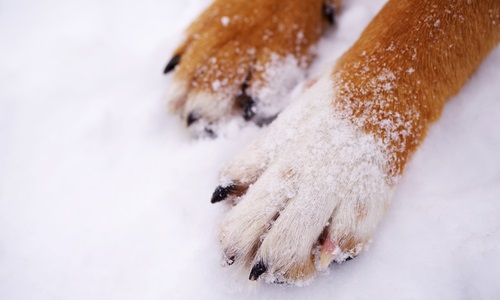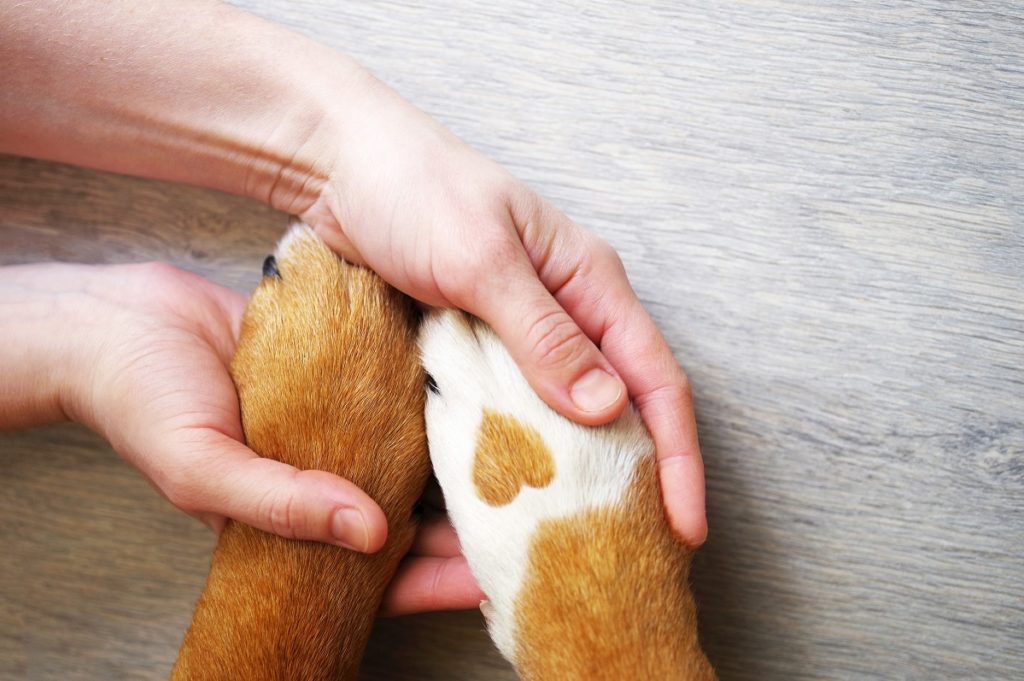A dog’s paws help him interact with the world in every way: from running, jumping, and digging in his home terrain to holding down toys and food, these important appendages are crucial to his happiness and survival. That’s why, when canine health issues threaten the comfort and usefulness of his paws, his pet parents need to recognize the problem and render assistance as soon as possible.
A fascinating component of canine anatomy, the paw pads are a nuanced and hardworking part of his body that deserves to be maintained and even occasionally pampered. When he’s experiencing discomfort or pain in his paw pads, knowing how to soothe his paws can make a huge difference in his quality of life.
Paw Pads Help Beat The Heat
Other than the nose, paw pads are one of the few places on a dog’s body that is naturally free of fur; that’s why they’re vital to helping him shed heat when the weather warms up. On some “naked” breeds, such as the exotic Xoloitzcuintli and Chinese Crested, there may be more surface skin exposed, but paw pads still factor prominently into cooling on a biological level. With that in mind, dog booties or other paw coverings are a great choice for pad protection in cold or snowy weather, but shouldn’t be left on for long periods of time in the summer, as they can contribute to overheating.
While pads naturally develop protective callouses, just like barefoot humans will over time, they’re still vulnerable to hot surfaces. A good rule of thumb when considering a walk in high temperatures is to place the back of the hand against the sidewalk, asphalt, or other walking surface and hold it in place for seven seconds. If it hurts or it’s a struggle to do so, that surface isn’t safe for dog’s paws. The same technique can be used on snowy or icy terrain: if a human hand can’t take the temperature, a dog shouldn’t be expected to do so either.
Dog Paw Pads Are Specialized Skin

Believe it or not, paw pads – those tough, lifelong “shoes” worn by every dog – are really just skin wrapped over fat pads. The toughened skin on the bottom of each paw works in concert with the underlying fat pads, which act like a shock absorber as he runs and jumps through his environment. With that in mind, the pads are subject to all the same worries that human palms and foot soles are:
- Scratches, scrapes, and dog blisters: Though nimble and fast, dogs can be just as clumsy or accident-prone as their human companions, at times. Whether it’s particularly rough asphalt, rocky terrain, or a stray piece of broken glass, cuts and scrapes can and do injure vulnerable paw pads. When this happens, superficial injuries should be cleaned regularly to prevent infection during healing. Deeper wounds or punctures should be seen by a vet for potential stitches or glue.
- Allergies and rashes: While the callous layer does provide a little more protection than human skin, it’s just as susceptible to seasonal allergies, insect bites, and contact rashes from allergy-causing substances. Pet parents should familiarize themselves with how their dog’s paws look “normally” so they can identify the presence of pad discoloration, swelling, and similar afflictions at a glance. If dog allergies are to blame, a vet can prescribe an oral or topical antihistamine treatment to combat the reaction to give an itchy dog some much-needed relief.
- Burns and freezing: Most pet owners are diligent enough to limit their dog’s exposure to very hot or very cold surfaces, but mistakes happen. If an escape-artist canine slips under a fence in extreme weather, he may return from his escapades with injuries to his feet. If the problem only looks to be superficial or of mild discomfort, the question of how to soothe a dog’s paw pads can be answered the same way it would be for overheated or very cold human hands: ensuring the affected skin is brought gradually and safely to room temperature, moisturizing, loose protective wrapping, and time. If a dog is struggling to walk on his paws or is yelping, however, emergency vet medical treatment is needed immediately to address the severity.
- Unwanted hitchhikers: Because a dog moves through his world “barefoot,” he’s susceptible to many of the dangers that shoes ward off in humans. Ticks, fleas, and skin-based parasites may travel up his legs or between his paw pads. Stepping the wrong way, particularly at a high rate of speed, can cause plant elements like painful burrs or stickers to get caught between his toes. After any hike or time in wooded territory, it’s good practice for pet parents to give their dog’s paws a thorough once-over to check for these potentially painful stowaways.
- Fungus and bacteria: Dogs don’t typically have the option of hopping in the shower when they need to clean off, and they will lick their paw pads if they need to be cleaned, become itchy, or feel painful. The downside of this behavior is that licking from paw-to-paw can unwittingly spread harmful, smelly bacteria to the spaces between toes, where it thrives. Even if a dog lives in a meticulously clean environment, one trip to the dog park or a walk through a field can cause him to bring home these smelly microscopic organisms. Again, the key to keeping him bacteria and foot fungus-free is observation and routine cleaning; paw-washing “tumbler” cups are a great tool for pet parents eager to clean up his paws after a visit to the dog park or a long walk.
- Anxiety and behavioral issues: Not all dog paw pad injuries are from external substances or accidents. Just as humans may bite at their nails or cuticles, or children might suck their thumb to soothe themselves, some anxious dogs bite or lick their paws habitually. This problem can be solved by adding more enrichment – toys, treats, and so on – to his environment, adding calming supplements to his diet, or ensuring that he feels more safe and secure in the home with items like an enclosed dog bed.
Paw Pads Work With His Nails
A dog’s nails grow like human nails do – curving up, out, and down towards the ground. While everyday movement and activity will generally keep the length of his nails in check, a slight twist here or a bend there can cause painful problems that will, in time, affect his paw pads as well. Just as a human’s gait might be affected by an ingrown toenail, a dog nail or dewclaw that grows or bends the wrong way can scratch or even puncture a paw pad. One way to avoid this potential problem is to commit to regular canine nail maintenance. Here are a few rules of thumb to keep in mind:

- A dog’s nails should be long enough to avoid exposure to the “quick” – a blood-filled vein that runs down the core of each cylindrical nail. This length helps him maintain an even stance and gait without compromising the health of his paws.
- Nail clipping should not be done with a traditional human nail clipper; this design is made for flat nails, and may cause splintering or painful pinching when used on a cylindrical canine nail. Instead, use a grinding wheel-type nail trimmer or a “cigar cutter”-style nail clipper intended for animal claws: these will provide a clean, healthy, and consistent cut to each nail.
- If professional help is preferred, most groomers and even vet offices can either provide that service or direct a pet parent to someone who can. For most breeds, clipping and/or examining nails every 3 to 4 weeks should be sufficient to maintain good health and hygiene.
- Nail maintenance helps protect his paw pads from movement-based irritation and scratching, but will also help avoid infection-prone wounds. If the nails are left too long, these wounds can develop on the skin, belly, ears, and face in response to scratching hot spots, rashes, or insect bites elsewhere on his body.
Be Cautious With Topical Treatments
Dogs lick and nip at their paws to soothe themselves, so any pet parent researching how to soothe a dog’s paws needs to bear this in mind. While there are a number of human salves and balms on the market for cracked or dry skin, many of these can harm a dog – both through digestion (licking) or absorption (skin). For the safest paw pad treatments, dog-safe and dog-specific products are the best option; when in doubt, a vet can recommend a high-quality brand or product.

Soothing a dog’s paw pads is a feat accomplished through equal parts observation, intuition, and the appropriate dog-safe products. These may include toys, anxiety-beating supplements, antibiotics, or topical treatments, depending on what’s called for with his specific paw issues. With a little love and care, however, he’ll be back “up on his paws” in no time, free of paw pad pain, irritation, or injuries.
Sources Cited:
1) Kucera, Tabitha, RVT, CCBC, KPA-CTP. “8 Common Dog Paw Problems.” The Spruce Pets.com, May 12, 2020, https://www.thesprucepets.com/dog-paw-problems-4584406. Accessed July 25, 2020.
2) Grieves, Deidre. “9 Common Paw Problems in Dogs.” PetMD.com, June 3, 2016, https://www.petmd.com/dog/slideshows/10-common-paw-problems-dogs. Accessed July 25, 2020.
3) Madson, Cathy, MA, CBCC-KA, CPDT-KA. “How to Properly Care for Your Dog’s Paw Pads.” Preventive vet.com, April 25, 2019, https://www.preventivevet.com/dogs/how-to-properly-care-for-your-dogs-paw-pads. Accessed July 25, 2020.
4) “Paw Problems: Burns, Blisters and Sores.” Pet Assure.com, (no publish date), https://www.petassure.com/new-newsletters/paw-problems/. Accessed July 25, 2020.
5) Burke, Anna. “Do Dogs Sweat?” AKC.org, June 2, 2020, https://www.akc.org/expert-advice/health/do-dogs-sweat/. Accessed July 25, 2020.




